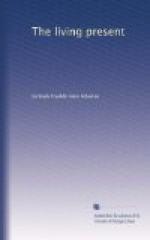“Professor Karl Pierson finds in the study of witchcraft some of the fossils that point back to the Matriarchate. In the older traditions ’the witch resumes her old position as the wise-woman, the medicine woman, the leader of the people, the priestess.’ ’We have accordingly to look upon the witch as essentially the degraded form of the old priestess, cunning in the knowledge of herbs and medicine, jealous of the rights and of the goddess she serves, and preserving in spells and incantations such wisdom as early civilization possessed.’
“The witch’s weather wisdom is congruent with the fact that women were the earliest agriculturists; her knowledge of herbs with that of the ancient medicine women; her diablerie with that of the ancient group relations of the sexes so different from what we call marriage to-day; her nocturnal dances with the ancient choruses of marriage-ripe maidens. The authority and magic circle kept by the broom are those of the hearth and floor in her primeval roundhut; and her distaff and pitchfork, her caldron, her cat and dog, are all in keeping with the role of woman in the Mother-Age.
“But there is another way, and that certainly not less reliable, by which we can arrive at some understanding of the Mother-Age, and how it naturally came about, namely, by a study of our ’contemporary ancestors,’ of people who linger on the matriarchal level. Such people, as well as others on the still lower nomad stage of civilization, are to be found at this day in Australia.
“While the purely nomad stage lasted, little progress could be made, because the possessions of a group were limited by the carrying powers of its members. But in a favorite forest spot a long halt was possible, the mothers were able to drop their babies and give a larger part of their attention to food-getting. As before, the forest products—roots and fruits—were gathered in, but more time and ingenuity were expended in making them palatable and in storing them for future use. The plants in the neighborhood, which were useful for food or for their healing properties, were tended and kept free of weeds, and by and by seeds of them were sown in cleared ground within easy reach of the camp. Animals gathered about the rich food area, and were at first tolerated—certain negro tribes to-day keep hens about their huts, though they eat neither them nor their eggs—and later encouraged as a stable source of food-supply. The group was anchored to one spot by its increasing possessions; and thus home-making, gardening, medicine, the domestication of animals and even agriculture, were fairly begun. Not only were all these activities in the hands of women, but to them, too, were necessarily left the care and training of the young.
“The men meanwhile went away on warlike expeditions against other groups, and on long hunting and fishing excursions, from which they returned with their spoils from time to time, to be welcomed by the women with dancing and feasting. Hunting and war were their only occupations, and the time between expeditions was spent in resting and in interminable palavers and dances, which we may perhaps look upon as the beginnings of parliaments and music halls.




